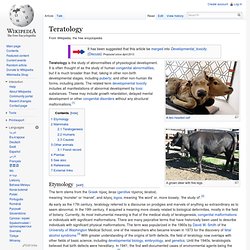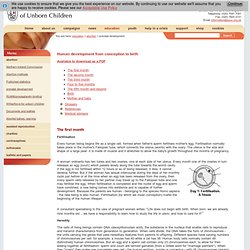

Teratology. A grown steer with five legs.

Teratology is the study of abnormalities of physiological development. It is often thought of as the study of human congenital abnormalities, but it is much broader than that, taking in other non-birth developmental stages, including puberty; and other non-human life forms, including plants. The related term developmental toxicity includes all manifestations of abnormal development by toxic substances.
These may include growth retardation, delayed mental development or other congenital disorders without any structural malformations.[1] Etymology[edit] The term stems from the Greek τέρας teras (genitive τέρατος teratos), meaning 'monster' or 'marvel', and λόγος logos, meaning 'the word' or, more loosely, 'the study of'.[2] As early as the 17th century, teratology referred to a discourse on prodigies and marvels of anything so extraordinary as to seem abnormal.
Mammalia[edit] Teratogenesis[edit] Humans[edit] Causes[edit] Other animals[edit] Fossil record[edit] Placenta. The word placenta comes from the Latin word for cake, from Greek πλακόεντα/πλακοῦντα plakóenta/plakoúnta, accusative of πλακόεις/πλακούς plakóeis/plakoús, "flat, slab-like",[2][3] in reference to its round, flat appearance in humans.

The classical plural is placentae, but the form placentas is common in modern English and probably has the wider currency at present. Prototherial (egg-laying) and metatherial (marsupial) mammals produce a choriovitelline placenta that, while connected to the uterine wall, provides nutrients mainly derived from the egg sac. The placenta functions as a fetomaternal organ with two components: the fetal placenta (Chorion frondosum), which develops from the same blastocyst that forms the fetus, and the maternal placenta (Decidua basalis), which develops from the maternal uterine tissue.[4] Structure[edit] Physiology[edit] Development[edit] The placenta begins to develop upon implantation of the blastocyst into the maternal endometrium. Placental circulation[edit] Human development from conception to birth. Available to download as a PDF Fertilisation Every human being begins life as a single cell, formed when father's sperm fertilises mother's egg.

Fertilisation normally takes place in the mother's Fallopian tube, which connects the uterus (womb) with the ovary. The uterus is the size and shape of a large pear: it is made of muscle and it stretches to allow the baby's growth throughout the months of pregnancy. A woman ordinarily has two tubes and two ovaries, one at each side of her uterus.